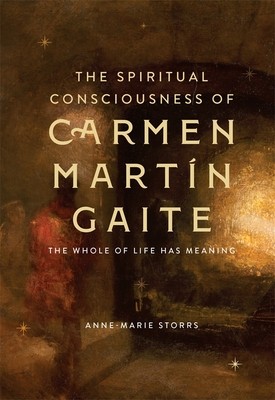
- We will send in 10–14 business days.
- Author: Anne-Marie Storrs
- Publisher: Tamesis Books
- ISBN-10: 1855663880
- ISBN-13: 9781855663886
- Format: 15.6 x 23.4 x 1.4 cm, kieti viršeliai
- Language: English
- SAVE -10% with code: EXTRA
The Spiritual Consciousness of Carmen MartÃn Gaite (e-book) (used book) | bookbook.eu
Reviews
Description
Spanish writer Carmen MartÃn Gaite (1925-2000) defined religioso as the reconnection of that which was previously united, namely, the day-to-day and supernatural worlds - here defined as consciousness and the unconscious, bringing awareness and wholeness. In this book, MartÃn Gaite's religious outlook is explored through the inner journeys of five female characters in El balneario, Lo raro es vivir, Irse de casa and Nubosidad variable.
Spanish writer Carmen MartÃn Gaite (1925-2000) defined religioso as the reconnection of that which was previously united, namely, the day-to-day and supernatural worlds - here defined as consciousness and the unconscious, bringing awareness and wholeness. In this book, MartÃn Gaite's religious outlook is explored through the inner journeys of five female characters in El balneario, Lo raro es vivir, Irse de casa and Nubosidad variable. For MartÃn Gaite, a truly religious, or spiritual, perspective requires conscious attention to the products of the unconscious (dreams, images, memories, premonitions), followed by reflection and action, as well as a similar attentiveness and responsiveness to external events both large and small. This reconnection of the supernatural and day-to-day worlds also involves descent to the unconscious - the way to wholeness - as depicted in so many myths and fairy tales, including those which MartÃn Gaite used to retell or enhance the works analysed in this book: Sleeping Beauty, The Little Mermaid, Amor and Psyche, Demeter and Persephone, and the Descent of the Goddess Inanna. Looking at the extent to which these female characters attend to, reflect on, and respond to their dreams, images, memories and events, the analysis suggests that MartÃn Gaite uses her stories to try to communicate both the road to her own enlightenment and warnings about paths that lead away from this.EXTRA 10 % discount with code: EXTRA
The promotion ends in 23d.18:32:04
The discount code is valid when purchasing from 10 €. Discounts do not stack.
- Author: Anne-Marie Storrs
- Publisher: Tamesis Books
- ISBN-10: 1855663880
- ISBN-13: 9781855663886
- Format: 15.6 x 23.4 x 1.4 cm, kieti viršeliai
- Language: English English
Spanish writer Carmen MartÃn Gaite (1925-2000) defined religioso as the reconnection of that which was previously united, namely, the day-to-day and supernatural worlds - here defined as consciousness and the unconscious, bringing awareness and wholeness. In this book, MartÃn Gaite's religious outlook is explored through the inner journeys of five female characters in El balneario, Lo raro es vivir, Irse de casa and Nubosidad variable.
Spanish writer Carmen MartÃn Gaite (1925-2000) defined religioso as the reconnection of that which was previously united, namely, the day-to-day and supernatural worlds - here defined as consciousness and the unconscious, bringing awareness and wholeness. In this book, MartÃn Gaite's religious outlook is explored through the inner journeys of five female characters in El balneario, Lo raro es vivir, Irse de casa and Nubosidad variable. For MartÃn Gaite, a truly religious, or spiritual, perspective requires conscious attention to the products of the unconscious (dreams, images, memories, premonitions), followed by reflection and action, as well as a similar attentiveness and responsiveness to external events both large and small. This reconnection of the supernatural and day-to-day worlds also involves descent to the unconscious - the way to wholeness - as depicted in so many myths and fairy tales, including those which MartÃn Gaite used to retell or enhance the works analysed in this book: Sleeping Beauty, The Little Mermaid, Amor and Psyche, Demeter and Persephone, and the Descent of the Goddess Inanna. Looking at the extent to which these female characters attend to, reflect on, and respond to their dreams, images, memories and events, the analysis suggests that MartÃn Gaite uses her stories to try to communicate both the road to her own enlightenment and warnings about paths that lead away from this.

Reviews